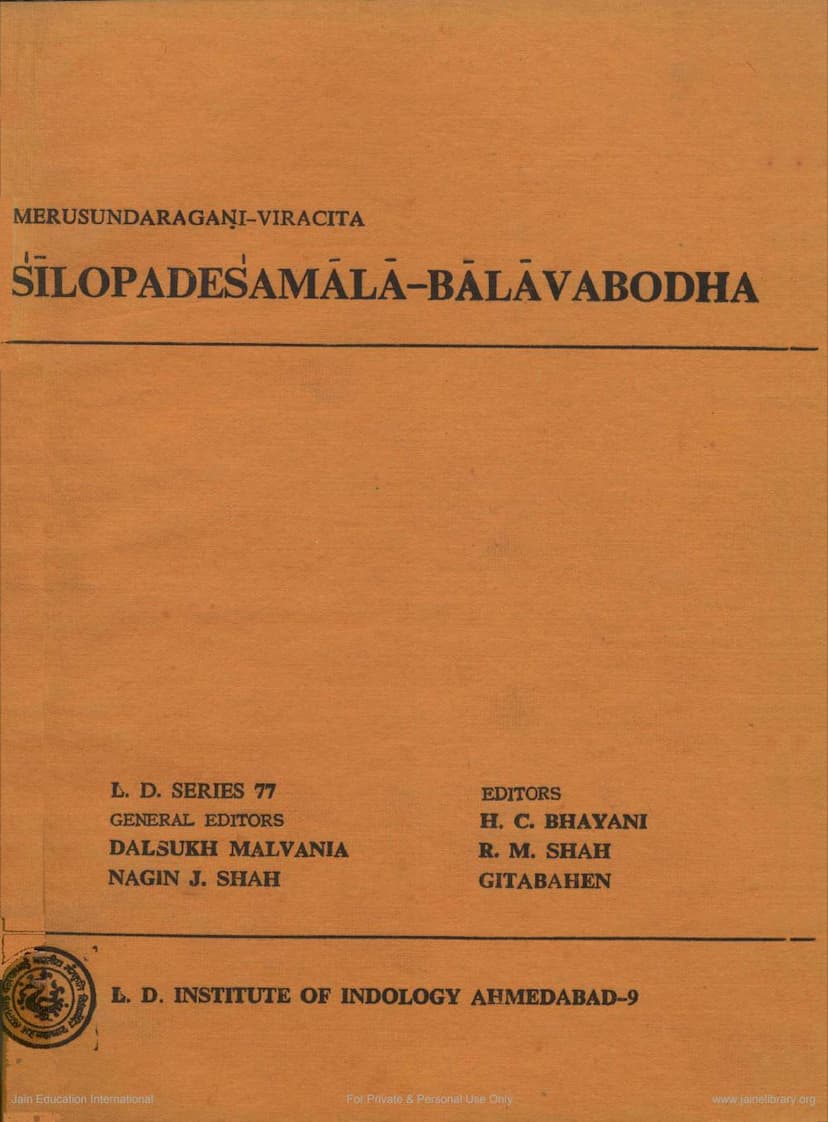Silopadesamala Balavbodh
Added to library: September 2, 2025

Summary
The book "Śīlopadeśamālā Bālāva<u>bōdha</em>" by Merusundaragani, edited by H. C. Bhayani, R. M. Shah, and Gitaben, and published by L. D. Institute of Indology, Ahmedabad, is a significant contribution to the study of ancient Gujarati prose literature. This comprehensive summary aims to capture the essence and importance of this Jain text, drawing from the provided pages of the book:
1. Title and Author:
- Book Title: Śīlopadeśamālā Bālāva<u>bōdha</em>
- Author: Merusundaragani (Merusundar Gani/Upadhyay)
- Editors: H. C. Bhayani, R. M. Shah, Gitaben
- Publisher: L. D. Institute of Indology, Ahmedabad
2. Nature and Purpose of the Text:
- The book presents the "Bālāva<u>bōdha</em>" (explained as a descriptive prose translation in old Gujarati) of the original Prakrit work "Śīlopadeśamālā" (Śīlopadeśamālā) composed by Jayakirti, a disciple of Jayasinghasuri, in 114 gāthās (verses) in the Arya meter.
- The "Bālāva<u>bōdha</em>" literature, which began appearing from the latter half of the 13th century CE, aimed to explain complex religious, philosophical, or instructional texts in Sanskrit and Prakrit to a lay audience, particularly those with limited knowledge of these languages, referred to as "bāla" (childlike, ignorant, or young).
- Merusundaragani's Bālāva<u>bōdha</em>, dating to the 16th century CE, is valuable for understanding the development of Gujarati prose during that period.
3. Content and Structure:
- The core of the Bālāva<u>bōdha</em> is the detailed prose explanation of the original Prakrit verses.
- A significant portion of the text (approximately 43 narratives) is dedicated to the stories and illustrative examples (dṛṣṭānta) used in the Śīlopadeśamālā. These stories are presented in a developed narrative form, expanding the original brief references.
- The book includes an extensive introduction (Bhūmikā) covering:
- An overview of ancient Gujarati prose and Bālāva<u>bōdha</em> literature.
- Introduction to the original Prakrit Śīlopadeśamālā and its author, Jayakirti.
- Sanskrit and Gujarati commentaries on the Śīlopadeśamālā.
- Information about Merusundar Upadhyay, the author of this Bālāva<u>bōdha</em>, and his other works.
- A description of the text itself, its context, and the editorial methodology.
- Linguistic analysis of the Bālāva<u>bōdha</em>'s language.
- The book also features:
- An alphabetical index of the original Śīlopadeśamālā gāthās.
- An alphabetical index of Sanskrit and Prakrit verses quoted in the Bālāva<u>bōdha</em>.
- A glossary of important words with their meanings.
4. Significance of Merusundaragani's Bālāva<u>bōdha</em>:
- Linguistic Value: The text is a rich source for studying the Gujarati language of the 15th century, showcasing its vocabulary, grammar, and stylistic features. The editors have meticulously noted linguistic peculiarities.
- Literary Value: The Bālāva<u>bōdha</em> provides detailed narratives for the stories mentioned in the original text. This aspect is valuable for scholars of folklore, narrative traditions, and literary history. Merusundaragani's skillful storytelling is highlighted.
- Theological and Ethical Content: The Śīlopadeśamālā, and by extension its Bālāva<u>bōdha</em>, focuses on śīla (virtue, good conduct, chastity) in Jainism. It emphasizes the importance of observing śīla, detailing the harms of its breach and the benefits of its observance through various examples.
- Scholarly Edition: The editors have undertaken meticulous research, basing their edition on six ancient manuscripts. They have also corrected the earlier published versions of the original gāthās, which were found to be error-ridden, by comparing various manuscripts and considering metrical rules.
5. Key Themes and Stories:
- The Bālāva<u>bōdha</em> elaborates on the core message of śīla (virtue).
- The text retells and expands upon numerous stories, including:
- The story of Guṇasundarī.
- The tales of sages like Dvipāyana and Viśvāmitra.
- Illustrative stories about kings like Ripumardan and Vijayapāla.
- Narratives about prominent figures in Jain tradition like Neminātha, Mallinātha, Sthūlabhadra, and Vajrasvāmi.
- Stories of virtuous women like Satyā Sūbadrā, Madanalekhā, Añjanā Sundarī, and Śīlavatī.
- Stories illustrating the consequences of violating or upholding virtue.
6. Linguistic Features (as noted in the Introduction):
- Sanskrit Influence: The text shows the influence of Sanskrit through the inclusion of numerous tatsama or near-tatsama words and verb forms (e.g., prasād, apahṛ, visarju).
- Prakrit Influence: Prakrit influences are evident in various words and grammatical structures derived from the source language (dhātu-sampaj, paḍivaj, ahiāsa, āloya).
- Persian/Arabic Influence: Some words of Persian or Arabic origin are also incorporated (kāgal, kārkhāna, kharac, bagal, bandovāṇa, majūr).
- Stylistic Elements: The prose is described as avoiding excessive ornamentation and verbosity, while still being engaging with descriptions, emotional portrayals, and dialogues. It also incorporates some descriptive passages (doṇakā varṇanō).
- Grammatical Observations: The introduction provides detailed observations on phonetic changes (dhvanitattva), morphological variations (rūptattva), noun structures (nāmika aṅga), verbal conjugations (ākhyātik aṅga), sandhi, and the use of particles (nipāta) and compound words (samāsa).
7. Editorial Contributions:
- The editors, led by H. C. Bhayani and R. M. Shah, have done commendable work in the critical edition of the Bālāva<u>bōdha</em>.
- They have utilized multiple manuscripts for text reconstruction and normalization.
- The detailed introduction and the various indices contribute significantly to the scholarly value of the publication.
- The project received financial assistance from the Government of Gujarat.
In essence, "Śīlopadeśamālā Bālāva<u>bōdha</em>" by Merusundaragani is a valuable resource for scholars of Jainism, Gujarati literature, linguistics, and cultural history. It offers a blend of ethical teachings, captivating stories, and linguistic insights from medieval India.